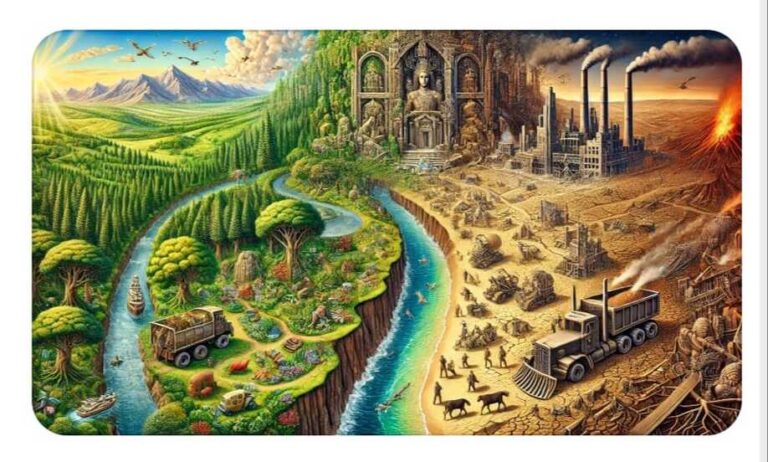![]()
Forests Precede Civilisations and Deserts Follow Them
It is a powerful observation about the impact of human civilisation on the environment and nature. It highlights the idea that forests, as natural ecosystems, existed long before human societies developed. However, as civilizations expanded, human activities such as deforestation, agriculture, urbanization, and industrialization led to environmental degradation, often transforming once fertile lands into deserts. This phrase serves as both a historical reflection and a cautionary warning about unsustainable development.
Forests as the Foundation of Civilization
Forests have played a crucial role in the development of human societies. Early human settlements thrived in and around forests because they provided essential resources such as food, water, shelter, and medicinal plants. Ancient civilizations like the Mesopotamians, Egyptians, Chinese, and Indus Valley peoples all relied on forests for wood, fuel, and raw materials for construction. The abundance of forests also influenced climate patterns, ensuring adequate rainfall and maintaining soil fertility, which allowed agriculture to flourish.
Many of the world’s greatest civilizations emerged in regions where forests were abundant, enabling them to sustain large populations. Forests also provided hunting grounds and materials for tools and weapons. In addition, they played a spiritual and cultural role in many ancient societies, influencing religious practices, myths, and traditions.
The Impact of Civilization on Forests
As human populations grew and civilizations expanded, the demand for land and resources increased. Large-scale deforestation began with agricultural activities, as people cleared vast forested areas to create farmland. The rise of industries, particularly during the Industrial Revolution, accelerated deforestation due to the need for timber, charcoal, and land for urban development.
Historically, many great civilizations, such as the Mesopotamians, Mayans, and Romans, experienced environmental decline due to excessive deforestation. The loss of trees led to soil erosion, depletion of water sources, and desertification. Without forests to regulate rainfall and retain moisture, once-fertile lands turned into arid regions, making it difficult for civilizations to sustain themselves. This environmental destruction often contributed to the decline and eventual collapse of these civilizations.
Deserts as a Consequence of Human Activity
When forests disappear, the land becomes vulnerable to desertification—a process where fertile soil gradually becomes desert-like due to erosion, overgrazing, and climate change. Deforestation disrupts the water cycle, reduces soil fertility, and leads to the loss of biodiversity.
One of the most well-known examples of desertification is the Middle East, where ancient civilizations like Sumer, Babylon, and Persia once flourished. Overexploitation of natural resources and poor land management led to the degradation of fertile land, turning it into dry, barren landscapes. Similarly, parts of North Africa, including regions that were once part of the Roman Empire, have experienced severe desertification due to centuries of deforestation and unsustainable agricultural practices.
In modern times, the Amazon Rainforest, often called the “lungs of the Earth,” is facing rapid deforestation due to logging, agriculture, and urban expansion. If this destruction continues, it could lead to severe climate disruptions, affecting global weather patterns and increasing the risk of desertification in surrounding areas.
A Lesson for the Future
The phrase “forests precede civilization and deserts follow them” serves as a warning for contemporary societies. History has shown that civilizations that fail to manage their natural resources responsibly eventually face environmental collapse. To prevent further desertification and ecological destruction, nations must prioritize sustainable development, reforestation, and conservation efforts.
Afforestation (planting new trees) and sustainable land-use practices can help reverse desertification and restore degraded lands. Governments, organizations, and individuals must work together to combat deforestation and promote policies that protect the environment.
At the end, forests have always been the foundation of human civilization, providing essential resources and supporting life. However, when civilizations overexploit these resources without considering long-term consequences, they pave the way for environmental decline, turning once-thriving lands into deserts. By learning from history and taking proactive measures, humanity can ensure that forests continue to support future generations rather than becoming mere relics of the past.







